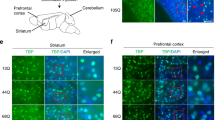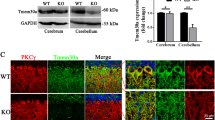Abstract
Spinocerebellar ataxia type 3 (SCA3) is caused by the abnormal expansion of CAG repeats within the ataxin-3 gene. Previously, we generated transgenic mice (SCA3 mice) that express a truncated form of ataxin-3 containing abnormally expanded CAG repeats specifically in cerebellar Purkinje cells (PCs). Here, we further characterize these SCA3 mice. Whole-cell patch-clamp analysis of PCs from advanced-stage SCA3 mice revealed a significant decrease in membrane capacitance due to poor dendritic arborization and the complete absence of metabotropic glutamate receptor subtype1 (mGluR1)-mediated retrograde suppression of synaptic transmission at parallel fiber terminals, with an overall preservation of AMPA receptor-mediated fast synaptic transmission. Because these cerebellar phenotypes are reminiscent of retinoic acid receptor-related orphan receptor α (RORα)-defective staggerer mice, we examined the levels of RORα in the SCA3 mouse cerebellum by immunohistochemistry and found a marked reduction of RORα in the nuclei of SCA3 mouse PCs. To confirm that the defects in SCA3 mice were caused by postnatal deposition of mutant ataxin-3 in PCs, not by genome disruption via transgene insertion, we tried to reduce the accumulation of mutant ataxin-3 in developing PCs by viral vector-mediated expression of CRAG, a molecule that facilitates the degradation of stress proteins. Concomitant with the removal of mutant ataxin-3, CRAG-expressing PCs had greater numbers of differentiated dendrites compared to non-transduced PCs and exhibited retrograde suppression of synaptic transmission following mGluR1 activation. These results suggest that postnatal nuclear accumulation of mutant ataxin-3 disrupts dendritic differentiation and mGluR-signaling in SCA3 mouse PCs, and this disruption may be caused by a defect in a RORα-driven transcription pathway.








Similar content being viewed by others
References
Zoghbi HY, Orr HT. Glutamine repeats and neurodegeneration. Annu Rev Neurosci. 2000;23:217–47.
Kawaguchi Y, Okamoto T, Taniwaki M, Aizawa M, Inoue M, Katayama S, et al. CAG expansions in a novel gene for Machado-Joseph disease at chromosome 14q32.1. Nat Genet. 1994;8:221–8.
Torashima T, Koyama C, Iizuka A, Mitsumura K, Takayama K, Yanagi S, et al. Lentivector-mediated rescue from cerebellar ataxia in a mouse model of spinocerebellar ataxia. EMBO Rep. 2008;9:393–9.
Qin Q, Inatome R, Hotta A, Kojima M, Yamamura H, Hirai H, et al. A novel GTPase, CRAG, mediates promyelocytic leukemia protein-associated nuclear body formation and degradation of expanded polyglutamine protein. J Cell Biol. 2006;172:497–504.
Oue M, Mitsumura K, Torashima T, Koyama C, Yamaguchi H, Furuya N, et al. Characterization of mutant mice that express polyglutamine in cerebellar Purkinje cells. Brain Res. 2009;1255:9–17.
Iizuka A, Takayama K, Torashima T, Yamasaki M, Koyama C, Mitsumura K, et al. Lentiviral vector-mediated rescue of motor behavior in spontaneously occurring hereditary ataxic mice. Neurobiol Dis. 2009;35:457–65.
Torashima T, Iizuka A, Horiuchi H, Mitsumura K, Yamasaki M, Koyama C, et al. Rescue of abnormal phenotypes in δ2 glutamate receptor-deficient mice by the extracellular N-terminal and intracellular C-terminal domains of the δ2 glutamate receptor. Eur J Neurosci. 2009;30:355–65.
Takayama K, Torashima T, Horiuchi H, Hirai H. Purkinje-cell-preferential transduction by lentiviral vectors with the murine stem cell virus promoter. Neurosci Lett. 2008;443:7–11.
Tamayose K, Hirai Y, Shimada T. A new strategy for large-scale preparation of high-titer recombinant adeno-associated virus vectors by using packaging cell lines and sulfonated cellulose column chromatography. Hum Gene Ther. 1996;7:507–13.
Miyake K, Miyake N, Yamazaki Y, Shimada T, Hirai Y. Serotype-independent method of recombinant adeno-associated virus (AAV) vector production and purification. J Nippon Med Sch. 2012;79:394–402.
Maejima T, Hashimoto K, Yoshida T, Aiba A, Kano M. Presynaptic inhibition caused by retrograde signal from metabotropic glutamate to cannabinoid receptors. Neuron. 2001;31:463–75.
Brown SP, Brenowitz SD, Regehr WG. Brief presynaptic bursts evoke synapse-specific retrograde inhibition mediated by endogenous cannabinoids. Nat Neurosci. 2003;6:1048–57.
Marcaggi P, Attwell D. Endocannabinoid signaling depends on the spatial pattern of synapse activation. Nat Neurosci. 2005;8:776–81.
Marcaggi P, Attwell D. Short- and long-term depression of rat cerebellar parallel fibre synaptic transmission mediated by synaptic crosstalk. J Physiol. 2007;578:545–50.
Safo P, Cravatt B, Regehr W. Retrograde endocannabinoid signaling in the cerebellar cortex. Cerebellum. 2006;5:134–45.
Hashimotodani Y, Ohno-Shosaku T, Kano M. Ca2+-assisted receptor-driven endocannabinoid release: mechanisms that associate presynaptic and postsynaptic activities. Curr Opin Neurobiol. 2007;17:360–5.
Kano M, Ohno-Shosaku T, Hashimotodani Y, Uchigashima M, Watanabe M. Endocannabinoid-mediated control of synaptic transmission. Physiol Rev. 2009;89:309–80.
Best AR, Regehr WG. Identification of the synthetic pathway producing the endocannabinoid that mediates the bulk of retrograde signaling in the brain. Neuron. 2010;65:291–2.
Mitsumura K, Hosoi N, Furuya N, Hirai H. Disruption of metabotropic glutamate receptor signalling is a major defect at cerebellar parallel fibre–Purkinje cell synapses in staggerer mutant mice. J Physiol. 2011;589:3191–209.
Serra HG, Duvick L, Zu T, Carlson K, Stevens S, Jorgensen N, et al. ROR[alpha]-mediated Purkinje cell development determines disease severity in adult SCA1 mice. Cell. 2006;127:697–708.
Hamilton BA, Frankel WN, Kerrebrock AW, Hawkins TL, Fitzhugh W, Kusumi K, et al. Disruption of the nuclear hormone-receptor ROR-alpha in staggerer mice. Nature. 1996;379:736–9.
Cvetanovic M, Patel JM, Marti HH, Kini AR, Opal P. Vascular endothelial growth factor ameliorates the ataxic phenotype in a mouse model of spinocerebellar ataxia type 1. Nat Med. 2011;17:1445–7.
Shakkottai VG, do Carmo Costa M, Dell’Orco JM, Sankaranarayanan A, Wulff H, Paulson HL. Early changes in cerebellar physiology accompany motor dysfunction in the polyglutamine disease spinocerebellar ataxia type 3. J Neurosci. 2011;31:13002–14.
Bezprozvanny I, Klockgether T. Therapeutic prospects for spinocerebellar ataxia type 2 and 3. Drugs Future. 2010;34:991–9.
Stevanin G, Duerr A, Brice A. Clinical and molecular advances in autosomal dominant cerebellar ataxias: from genotype to phenotype and physiopathology. Eur J Hum Genet: EJHG. 2000;8:4.
Seidel K, Siswanto S, Brunt EP, Dunnen W, Korf H-W, Rüb U. Brain pathology of spinocerebellar ataxias. Acta Neuropathol. 2012;124:1–21.
Sidman RL, Lane PW, Dickie MM. Staggerer, a new mutation in the mouse affecting the cerebellum. Science. 1962;137:610–2.
Albert RLS. Neurodegeneration: a case of arrested development? Cell. 2006;127:669–71.
Foust KD, Nurre E, Montgomery CL, Hernandez A, Chan CM, Kaspar BK. Intravascular AAV9 preferentially targets neonatal neurons and adult astrocytes. Nat Biotech. 2009;27:59–65.
Gray SJ, Matagne V, Bachaboina L, Yadav S, Ojeda SR, Samulski RJ. Preclinical differences of intravascular AAV9 delivery to neurons and glia: a comparative study of adult mice and nonhuman primates. Mol Ther. 2011;19:1058–69.
Miyake N, Miyake K, Yamamoto M, Hirai Y, Shimada T. Global gene transfer into the CNS across the BBB after neonatal systemic delivery of single-stranded AAV vectors. Brain Res. 2011;1389:19–26.
Acknowledgments
The authors are very grateful to Noriyuki Koibuchi for providing us with staggerer mutant mice. The authors would like to thank Dr. Andrey N. Shuvaev from the Institute of Undergraduate Core Programs, Siberian Federal University for his advice on our statistical analysis. This work was supported in part by the Funding Program for Next Generation World-Leading Researchers (LS021) to H. H and JSPS KAKENHI grant number 24700394 to A. K.
Conflict of Interest
All authors state that there are no actual or potential conflicts of interest concerning the work presented in this manuscript.
Author information
Authors and Affiliations
Corresponding author
Additional information
Ayumu Konno and Anton N. Shuvaev contributed equally to this work.
Electronic Supplementary Material
Below is the link to the electronic supplementary material.
ESM 1
(PDF 1112 kb)
Rights and permissions
About this article
Cite this article
Konno, A., Shuvaev, A.N., Miyake, N. et al. Mutant Ataxin-3 with an Abnormally Expanded Polyglutamine Chain Disrupts Dendritic Development and Metabotropic Glutamate Receptor Signaling in Mouse Cerebellar Purkinje Cells. Cerebellum 13, 29–41 (2014). https://doi.org/10.1007/s12311-013-0516-5
Published:
Issue Date:
DOI: https://doi.org/10.1007/s12311-013-0516-5




